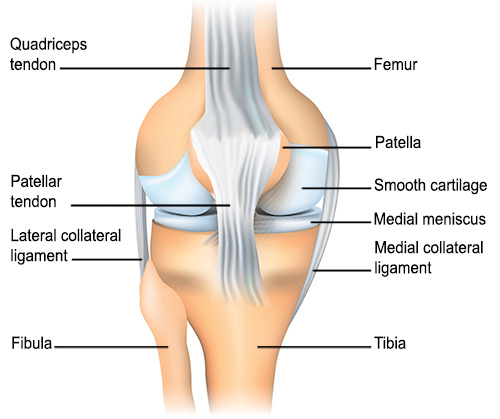Patellofemoral Disorders
Pain, swelling, stiffness or a buckling sensation in the knee can signal the presence of a wide variety of conditions or injuries that may affect the general population. But those who injure or aggravate their patellofemoral joint, where the end of the femur (the long bone in the thigh) meets the patella (the kneecap), or those who develop patellofemoral knee arthritis, often have specific complaints such as:
- Pain using stairs (especially down), going from sitting to standing, and sitting for long periods
- Instability where the kneecap moves in and out of the groove
- Imbalances, like tightness or knock-knees, that worsen the condition
Seeking prompt medical attention for injuries or disease that affect the patellofemoral joint can help assess the degree of risk present and minimize or prevent further injury.
Anatomy of the patellofemoral joint
In the healthy knee, the bones that make up the patellofemoral joint move smoothly against one another as the joint is bent or extended, with the patella gliding in a groove or trochlea of the femur. (The groove may also be referred to as the sulcus.) One of three compartments in the knee, together with the lateral compartment on the outside of the knee and the medial compartment on the inside, the patellofemoral joint is supported and stabilized by a complex network of ligaments, tendons and other soft tissues.

Diagram of the patellofemoral structures of the knee joint, including the patella (kneecap).
Treatment for patellofemoral disorders
With a range of effective non-operative and surgical procedures available, people with patellofemoral disorders now have a better chance of returning to pain-free function than ever before. However, because patellofemoral pain and instability can easily progress to patellofemoral arthritis if left untreated, individuals with these symptoms are advised to seek early evaluation.
Articles on patellofemoral disorders
Learn about various patellofemoral conditions, including runner's knee and patellar (kneecap) instability issues.
Articles on patellofemoral arthritis
Somewhat less common than typical knee arthritis, patellofemoral joint arthritis occurs when there is a loss of cartilage from the joint surface between kneecap and the groove on the thighbone in which it rests. Learn more in these articles.
Articles on surgical treatments for patellofemoral conditions
Learn about specfic surgeries for different patellofemoral conditions.
Reviewed and edited by Beth E. Shubin Stein, MD and Sabrina M. Strickland, MD
